Eugene Zhukau has always been interested in trees. He had a favorite in the neighborhood where he spent his childhood, in Minsk, Belarus. It was a horse chestnut tree, and he climbed it often. Now he lives in Provincetown, where he cares for trees for a living.
Zhukau, 33, first came here in 2010 on a J-1 student work visa. Later he studied cinematography in Moscow and worked for news agencies there and in Belarus. He returned to Provincetown in 2015 and applied for political asylum, “but the chance I’ll have an interview in this life is almost zero,” he says. In the meantime, he has a work permit, which allows him to run his small business. (He is also a part-time server at Mac’s Fish House in Provincetown.) “When I came to America, I needed a new start,” he says. “I thought working with trees would be a good thing to do.”
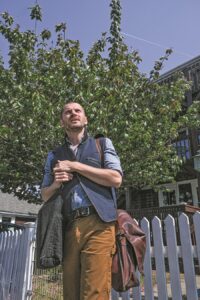
Standing outside the Commons, Zhukau begins a small tour of trees in Provincetown’s West End with commentary on the two Princeton elms flanking the front of the building.
“Provincetown used to have a lot of Dutch elms,” he says, “but they all died from Dutch elm disease. The Princeton elms are resistant. In old photographs they had two elms in front of this building. This is a re-creation.”
Farther down Bradford Street Zhukau points out a cherry tree in a yard. “This is an example of bad pruning,” he says. The tree likely outgrew its location, he guesses, so limbs were cut mid-branch, leaving large stubs from which smaller shoots have begun growing. Zhukau likens the tree to the mythological Hydra, a many-headed serpent who, when struggling with Hercules, sprouted two heads for each one that was cut off. The effect on this cherry tree is not elegant.
“In summer it looks good because of all the leaves,” says Zhukau. But winter is a different story. “When the leaves are gone with the tourists, you can see the true structure of Provincetown,” he says, referring both to its trees and its society.
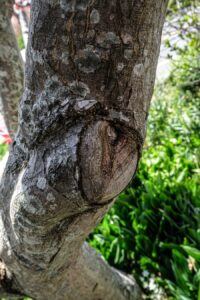
Mid-branch cuts are not good for the health of the tree, says Zhukau. “You can see big wounds that didn’t compartmentalize,” he says. “They are perfect holes for fungus and infection.”
Compartmentalization, a term coined by plant pathologist Alex Shigo, refers to a tree’s use of chemical and physical responses to limit decay after an infection. Zhukau says tree wounds don’t heal like a cut on your skin. The wound stays and the tree grows over it. Cherry trees don’t compartmentalize well, so pruning can leave the tree susceptible to infection. The new thin branches are also prone to breaking.
We enter the Bradford Street yard of one of Zhukau’s clients, landscape designer Greg Lombardi. His views of Provincetown Harbor from the second story were being blocked by a Japanese maple. When Lombardi moved in, the tree had a damaged root from compaction of soil during renovation. Lombardi asked Zhukau to prune the maple to improve the view and protect its health.
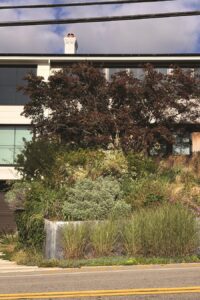
When Zhukau began working on the maple two years ago, the first thing he did was remove a branch that was heavily infected with fungus. Zhukau cut the branch at the union of two branches, rather than between nodes. “This way, the tree will direct the energy into another branch,” he says. Since then, the wound has compartmentalized, evidenced by the tissue that has grown over the cut. In lowering the height of the tree, he was careful not to cut more than 25 to 30 percent of its size. “A tree stores energy in its branches,” says Zhukau. “When you cut too severely, the tree doesn’t have an opportunity to produce food for itself and uses stored energy.”
At the rear of the property, he is working on a paper-bark maple, pruning to direct its growth upward and remove branches that might grow into each other.
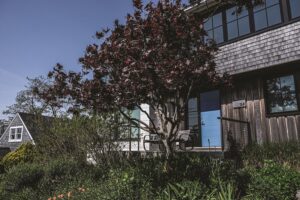
At a house on Commercial Street built in 1750, Zhukau shows off a 30-year-old wisteria that he has been pruning heavily to bring it into shape atop a pergola. “Wisteria is a strong plant and can destroy structures,” he says. “It was very wild when I started. Shoots were growing on the house.”
Walking back toward Bradford Street, he points out another property on Pleasant Street that he’s working on. With the wisteria, he’s creating a horizontal screen to provide shade; here, he’s creating a vertical screen by tightly pruning hornbeam trees to create a hedge.
Zhukau was introduced to aesthetic pruning in the Bay Area, where he spent a few winters. There, he says, the approach to maintaining trees reflects the Japanese aesthetic.
“In Japan,” he says, “they try to bring nature close to the house and maintain it on a human scale.” Zhukau studied aesthetic pruning at Merritt College in Oakland, learning how to make cuts and understand the ways trees react. “It’s something between art and craftsmanship,” he says.

Zhukau is one soil class shy of completing the arboriculture certificate program at UMass Amherst. He hopes to become a certified arborist through the International Society of Arboriculture.
As part of his studies, Zhukau created a “community forest inventory and master plan” for Provincetown’s trees. He knows the history of many of the trees in town. On Conant Street, he points out a large sycamore maple — they’re also known as planetrees — with broad leaves.
“This is a very invasive tree,” he says. They were planted because they’re salt resistant, but “they’re out of control, and they’ll grow anywhere where territory isn’t maintained.” He points out one in front of the William Raveis office on Commercial Street. The tree has a large gash in its trunk and dead branches. “It’s a public hazard,” says Zhukau.
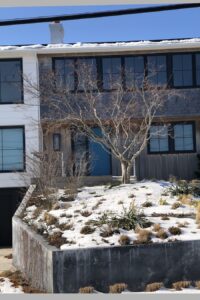
Walking past the Bradford pear at Liz’s Café, he lists the species’ drawbacks. Their branches are prone to breaking under the weight of snow or other stresses; their flowers smell like urine; they don’t compartmentalize well; and they will cross-pollinate and disrupt the fruit production of other pear trees. They were overplanted in Provincetown, says Zhukau, as they have been in suburban developments across the country.
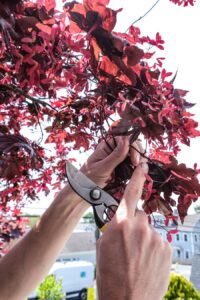
Back at the Commons, Zhukau inspects an inkberry bush. He points out a brushy cut, likely made with a dull tool. “It’s just splitting the wood and creating an entrance for bad stuff,” he says. He notices a few dead branches at the bottom of the bush. After scraping the skin to make sure there’s no green, he snips off the branches.
“You have to remove dead branches to create space for the bush to send new shoots and to prevent decay,” he says. He does most of his pruning according to the idiosyncrasies of each tree and in the shoulder seasons, when the architecture of a tree is most apparent. But with a pair of sharp pruners in his hand, he can’t resist.
“The best time to prune is when you are standing in front of a tree and your pruners are sharp,” Zhukau says, quoting one of his teachers.



